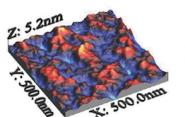A More Efficient Organic Polymer Cell

Organic polymer solar cells (PSC) are a promising new alternative to the inorganic devices that have long dominated the field. But their lack of efficiency – that is, how much electricity is needed compared to the input of sunlight – is a problem.
 However, researchers in Dr. Andre Taylor’s Transformative Materials & Devices Lab have developed a PSC that has surpassed the 10% efficiency rate – a milestone within photovoltaics circles. The results are published in Advanced Energy Materials. Dr. TengHooi Goh, a recent PhD graduate student in Taylor’s lab, is the lead author.
However, researchers in Dr. Andre Taylor’s Transformative Materials & Devices Lab have developed a PSC that has surpassed the 10% efficiency rate – a milestone within photovoltaics circles. The results are published in Advanced Energy Materials. Dr. TengHooi Goh, a recent PhD graduate student in Taylor’s lab, is the lead author.
Traditionally, silicon is the material used for most solar cells on the market today. But Taylor notes conventional silicon solar cells are close to their limit as far as improvements. So polymer cells, which cost less and weigh less, are a promising alternative. The problem with polymer cells, though, is that they generally fail to convert nearly half their absorbed light energy to electrical power.
To improve the conversion rate, Taylor’s research group has created a solar cell with an active layer consisting of multiple materials. It’s an approach that brings its own set of problems.
“Adding more materials to create a blend is the easiest strategy,” said Taylor, associate professor of chemical & environmental engineering. “But this can leave a negative impact on the active layer as the different chemicals typically possess disparate properties and can be incompatible to electron transport in the cells.”
As a solution, the Taylor lab looked to Förster resonance energy transfer (FRET), a process in which energy is transferred between closely spaced molecules. FRET is critical to how plant cells convert energy. In a previous study, the lab employed FRET while creating a PSC with a ternary structure (that is, containing three major components). The cell achieved an energy conversion rate of 4.5%. The result was promising, but the research team figured they could do better and continued to tinker with PSCs.
Most recently, they’ve developed a quaternary device (four components) – the first quaternary system within a FRET-based architecture – and achieved even better results. Working with Dr. Nilay Hazari and his team, they accomplished this by adding two types of a fluorescent organic dye. Known as squaraines, these dyes boost light absorption, recycle electrons, and enhance crystallinity of the organic layer. In addition to these squaraines, the active layer consists of the PTB7-Th polymer and a fullerene derivative. The final product is a cell that performs at an impressive 10.7% conversion rate.
The paper is titled “Quaternary Organic Solar Cells Enhanced by Co-crystalline Squaraines with Power Conversion Efficiencies >10%”. Other co-authors are Jing-Shun Huang, Kevin G. Yager, Matt. Y. Sfeir, C.-Y. Nam, Xiao Tong, Louise M. Guard, Patrick R. Melvin, Francisco Antonio, Ben G. Bartolome, Minjoo L. Lee. The National Science Foundation, Yale Climate and Energy Institute, Yale Institute of Nanoscience and Quantum Engineering, Yale Center for Research on Interface Structures and Phenomena, and U.S. Department of Energy provided support for the research.

